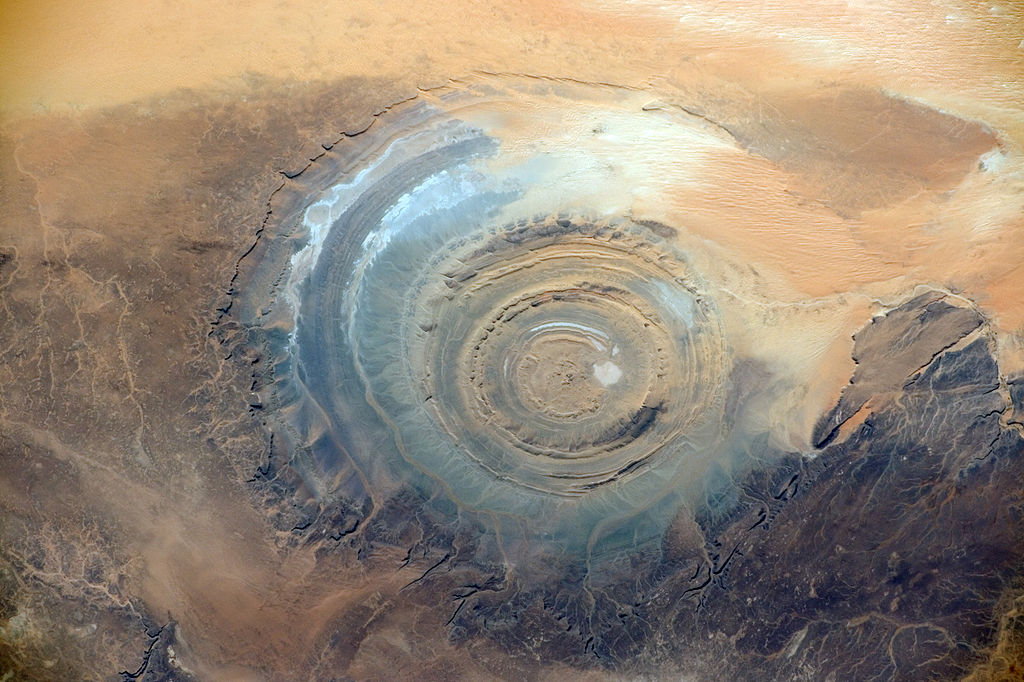Richat Structure: The Mysterious Eye of Richat
The Eye of Richat, also known as the Richat Structure or the Eye of the Sahara, are a fascinating geological formation located in the Sahara Desert of Mauritania. This natural wonder has captivated scientists and visitors alike for its distinct circular shape, resembling a giant pair of eyes when viewed from above. In this article, we will explore the geological origins of the Richat Structure, its unique features, and the various theories surrounding its formation.
Origins and Formation
The Richat Structure is an eroded dome-shaped feature with a diameter of approximately 50 kilometers (31 miles). Geologists believe that it was formed around 100 million years ago, during the Late Jurassic or Early Cretaceous period. While the exact process of its formation is still debated, the most widely accepted theory suggests that it was created by a combination of uplifted rock layers and subsequent erosion.
Distinctive Features
The Eyes of Richat exhibit several unique features that make it a captivating sight to behold. Its perfectly circular shape, visible even from space, is one of the most striking aspects. The outer ring of the structure is formed by layers of resistant rock, while the central part consists of softer materials that have eroded over time. The circular depression creates an intriguing contrast with the surrounding desert landscape.

The Richat structure photographed from the International Space Station. Astronauts aboard the International Space Station captured this image of a huge crater in Africa on Nov. 22, 2014. This is the Richat Structure in northwestern Mauritania, otherwise known as the “Eye of the Sahara.” Scientists are still deciding whether this was formed by a subterranean volcano or impact from a large meteor. Deep in the Sahara Desert it is nearly a perfect circle, it is 1.2 miles (1.9 kilometers) wide, and sports a rim 330 feet (100 meters) tall. The crater sits in a vast plain of rocks so ancient they were deposited hundreds of millions of years before the first dinosaurs walked the Earth. NASA, Public domain, via Wikimedia Commons
Geological Significance
Beyond its aesthetic appeal, the Richat Structure is of significant geological interest. It provides valuable insights into the complex processes that shape our planet’s surface. Geologists study the layers of rock exposed within the structure to gain a better understanding of the Earth’s geological history and the forces that have shaped it over millions of years.
Astronomical Hypotheses
The distinctive circular shape of the Richat Structure has also led to some astronomical hypotheses. Some researchers have suggested that the structure’s central peak resembles an impact crater caused by a meteorite. However, subsequent studies have ruled out this possibility, indicating that the formation is a result of geological processes rather than extraterrestrial impact.
Geographic Location
The Richat Structure is situated in the western part of Mauritania, near the town of Ouadane. It is located within the vast expanse of the Sahara Desert, making it a remote and challenging area to access. The nearest major city is Atar, which serves as a gateway for visitors interested in exploring this geological marvel.
Size and Scale
The diameter of the Richat Structure spans approximately 50 kilometers (31 miles). To put its size into perspective, it can be seen clearly from space, highlighting its immense scale and striking circular shape. When viewed from ground level, its grandeur becomes even more apparent as you witness the layers of rock and the contrasting colors within the structure.
Ecological Significance
While the Richat Structure is predominantly composed of rocks and sand, it supports a surprising variety of flora and fauna. The depression within the structure collects water during periods of rainfall, creating a unique microhabitat for plant life. Certain plant species, including desert-adapted trees and shrubs, have adapted to the arid conditions and thrive in this area.
Cultural and Historical Significance
The Eyes of Richat have captivated the human imagination for centuries. Local nomadic tribes have regarded the structure with reverence and attached various cultural and spiritual beliefs to its formation. Today, it is also a popular destination for geologists, researchers, and tourists who are drawn to its geological and aesthetic significance.

The inner circle of the structure. Clemens Schmillen, CC BY-SA 4.0, via Wikimedia Commons
Exploration and Tourism
While the Richat Structure is located in a remote area, it has gradually gained attention from adventurers, geologists, and travelers who seek to witness its beauty firsthand. Expeditions and guided tours are organized to explore the structure, providing visitors with a chance to appreciate its unique geological features and learn about its formation.
Future Research and Preservation
Ongoing scientific research aims to deepen our understanding of the Richat Structure and its geological history. As technology advances, new techniques such as remote sensing and advanced imaging methods contribute to further exploration and analysis of this enigmatic formation. Efforts are also being made to preserve and protect the structure, balancing tourism and scientific interest with its ecological integrity.
Conclusion
The Eyeof Richat in Mauritania stand as a testament to the Earth’s geological wonders. This enigmatic formation continues to intrigue scientists and spark the imagination of those who visit or study it. Whether contemplating its geological origins, appreciating its unique features, or pondering astronomical theories, the Richat Structure serves as a reminder of the Earth’s complex and captivating natural history.
[Link: https://www.sciencedirect.com/science/article/pii/S1342937X18303083]
Sources: PinterPandai, Geology Science, NASA (.gov)
Photo credit (main picture): NASA/GSFC/MITI/ERSDAC/JAROS, and U.S./Japan ASTER Science Team, Public domain, via Wikimedia Commons
Photo description: Guelb er Richat from space (false color representation).



